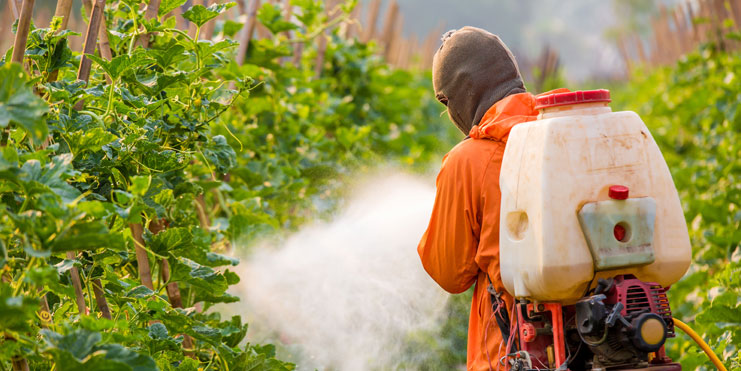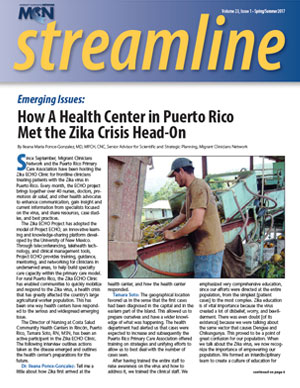Pesticide Handlers: New Rules on Medical Evaluations and Determinations

[Editor’s Note: In 2015, the Environmental Protection Agency updated its Worker Protection Standard, the primary set of regulations to protect agricultural workers on the job. The new WPS included important provisions to protect agricultural workers and pesticide applicators from pesticide exposure, among other protections. Many pieces of the newly revised WPS came into effect in January, 2017; others will be implemented in January 2018.]
Many provisions of the revised Worker Protection Standard came into effect in January, 2017. Among them were new provisions to protect the health of pesticide handlers. Pesticide handlers, broadly defined, are those who mix, load, or apply pesticides. Handlers are now required to undergo a one-time medical evaluation by a licensed health care provider and to complete respirator fit testing every year. The costs for the evaluation and fit testing are to be covered by the employer.
Medical Evaluation
Clinicians providing the medical evaluation determine whether the handler is physically able to use the required respirator needed for his/her job. The EPA outlines the requirements regarding the medical evaluation in its “How to Comply With the 2015 Revised Worker Protection Standard for Agricultural Pesticides,” the complete guide to all the WPS changes.
“Using a respirator is very important for the safety of a pesticide handler, but, for handlers with certain health conditions like asthma or emphysema, a respirator could potentially injure the handler or exacerbate his or her health condition,” said Ed Zuroweste, MD, Co-Chief Medical Officer of MCN. “The clinician must weigh the risk factors that may lead to injury, which include how often the handler will have to use the respirator, the conditions under which the respirator will be used, the type of respirator, and the severity of his or her health condition.”
Handlers are now required to undergo a one-time medical evaluation by a licensed health care provider and to complete respirator fit testing every year.
Under the new rules, the medical evaluation involves gathering information obtained from the handler as well as the handler’s employer. The handler must present the provider with a questionnaire completed by the employer which details the specifics of the handler’s job. In its guide, the EPA says the questionnaire outlines:
- The type and weight of respirator that the handler will use.
- How long and how frequently the handler will use the respirator.
- How much physical work the handler will do while using the respirator.
- Other PPE the handler will use.
- The temperature and humidity extremes of the working environment.
In addition to the form the employer completes, there is a confidential medical questionnaire detailing the handler’s health conditions that needs to be completed by the handler. A questionnaire, developed by the Occupational Safety and Health Administration (OSHA), is accessible on MCN’s website and meets EPA requirements. (See “Resources,” below.) Ideally, the handler should complete the questionnaire during work hours, but as it is confidential, should not share the results with the employer, OSHA, or any other regulatory body. The questionnaire is only to be shared with the provider at the time of the medical evaluation. For agricultural workers for whom English is often not their first language, and who may not be able to read well, the handler may need help from the health care provider or clinic staff to complete the form.
The Provider’s Determination
Once the provider has received and reviewed both questionnaires and seen the handler in the exam room, the provider may take a number of actions depending on the needs of the handler. The provider may order additional medical tests or procedures to further evaluate the handler, approve the medical release, either with or without conditions, or refuse to sign the medical release.
If any follow-up tests or procedures are needed, the provider will wait until they are completed to fill out the forms. The provider then may approve the medical release with certain conditions, which may include a requirement of a re-evaluation after a specific period of time and/or restrictions on the handler’s use of the respirator.
The medical release must contain the results of the medical evaluation, which the EPA details must include:
- Whether the employee is medically able to use a respirator;
- Any restrictions on the employee’s use of the respirator;
- The need for follow-up medical evaluations; and
- Verification that the provider has given the employee a copy of the written medical determination.
In addition to the medical evaluation, the newly revised WPS requires annual respirator fit testing. The testing must be repeated annually or whenever there’s a change -- either in the type of respirator or physiologically for the handler. At that time, the respirator is also checked to assure the seals are still properly functioning. These tests are performed on-site and do not require the presence of a health care provider.
Resources
Visit MCN’s “WPS Medical Evaluation Resources for Clinicians” page at https://goo.gl/1kVYD4 to find the following three resources:
- “How to Comply With the 2015 Revised handler Protection Standard for Agricultural Pesticides: What Owners and Employers Need To Know,” the Environmental Protection Agency’s complete guide;
- “How to Comply…” excerpt on medical evaluation and fit testing;
- OSHA Respirator Medical Evaluation Questionnaire.
Learn more about the breadth of changes to the WPS on MCN’s WPS page, https://goo.gl/1HKYYM. Read the “Clinician’s Guide to EPA’s Worker Protection Standard,” an updated guided created by MCN and Farmworker Justice, at https://goo.gl/ZEwjGe.
Read this article in the Spring/Summer 2017 issue of Streamline here!
Sign up for our eNewsletter to receive bimonthly news from MCN, including announcements of the next Streamline.
Return to the Streamline Spring/Summer 2017 Table of Contents.
